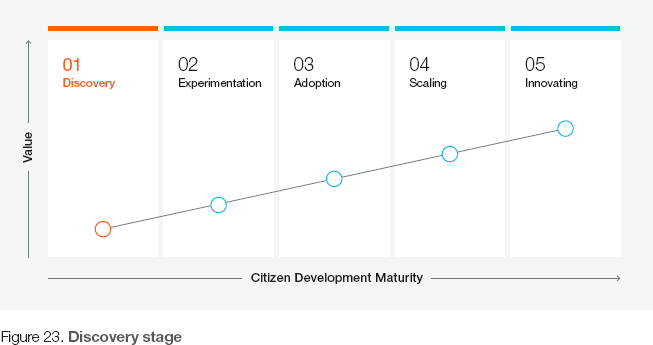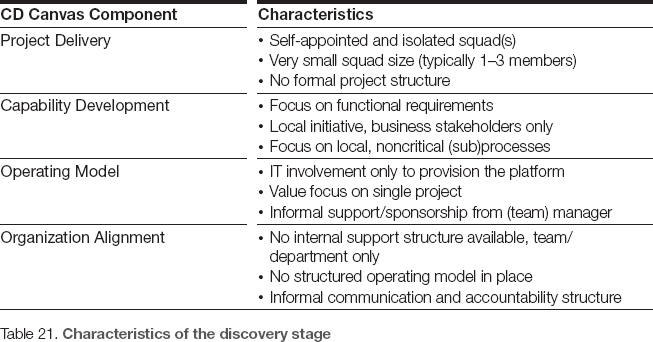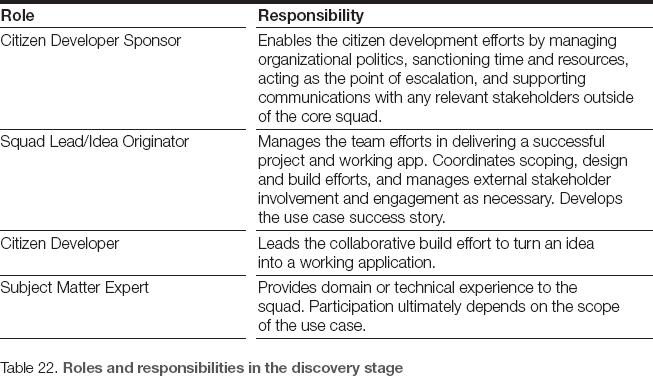| 6.1 Discovery |  |
Lay the foundations for citizen development adoption in your organization. Create the first app through citizen development. The discovery stage is an organization's first point of contact with citizen development on a small and discrete scale.
In this stage, citizen development remains focused on specific solutions to pain points, without formalized frameworks, methodologies, or structure to avoid the possibility of being overpowered by the established culture.

“Not all those who wander are lost.”
J.R.R. Tolkien
![]()
Overview
By its nature, citizen development tends to challenge the norms for organizations. It can be disruptive. If not harnessed properly in the early stages of maturity, it can quickly be overpowered by the prevailing culture. At the early stages, there are no formalized accountability or governance structures, and activities are typically performed on a best-endeavors basis (e.g., during lunch breaks). Any sponsorship for citizen development is likely to be guarded and clandestine in their support. All these factors threaten the likelihood of success for citizen development in the early stages (Figure 23).

There are several ways in which citizen development is first introduced into an organization. It might be that someone has brought the citizen developer experience into the organization from a previous role and sees a new opportunity, or an executive has heard about the benefits of citizen development and wants to sponsor a proof of concept. Perhaps the IT department is looking to resolve the shadow IT problem, or they are seeking new ways to address the constant demand from the business and the overflowing IT backlog. Regardless of how citizen development has been introduced, and regardless of which citizen development platform is being used, the first thing to do is assemble a squad and identify a suitable use case that can demonstrate quick, quantifiable value for the organization once delivered.
| DEFINITION |
Backlog
An accumulation of uncompleted work or matters needing to be dealt with (Google Dictionary, n.d.a.).
How to recognize the discovery stage
Table 21 outlines the characteristics of the discovery stage for each Canvas component.

Why is the discovery stage important?
•The discovery stage is likely the first time employees and managers get to experience citizen development, and first impressions are important.
•The discovery stage, more than any other stage, represents leading at the front line and decentralized decision making.
•The discovery stage promotes entrepreneurialism, collaboration, proactivity, and a strong sense of being a pioneer. This is the foundation of the culture and mindset, resulting in highly motivated, high-performing citizen developers.
•The discovery stage presents an opportunity for individuals to turn their ideas into applications, perhaps for the first time. It is a departure from the status quo of handing ideas to someone else to interpret and then try to build.
Discovery Stage in Practice
The discovery stage describes the early days of citizen development in an organization. In order for citizen development to really add value to the organization as a whole, it is important to actively work on evolving the maturity from stage to stage.
This stage concentrates around one (or a few) initial “one-off” projects. The goal is to focus on using citizen development to solve a local problem that will yield quantifiable value once addressed. This could be a pain point that a user identifies in their department or function or an interaction with another department, external customer, or supplier. It could be an existing shadow IT or an application that isn't fully fit for purpose.
Based on the Citizen Development Canvas, a number of actions and considerations are described in the following sections to push the maturity forward and prepare the organization for the next stage.
Project delivery
Identify the right use cases.
The pioneer citizen development project seeks to build an application (app). It should be one that is not overly complex and does not require extensive integration or new hardware that would necessitate wider stakeholder engagement, buy-in, and coordination. It is also recommended to identify a use case that does not involve any significant security or compliance exposure. The app will be created outside of formalized governance and control structures, likely with very limited or no budget. Find a use case that involves a problem or opportunity your team is currently grappling with. Perhaps you have manual processes you would like to automate. Do you have an existing process that could use new time-saving functions? A good place to start is to look at existing tools and spreadsheets that your team currently uses, where the underlying process, data fields, actions, and outputs are already well defined.
Select the right squad.
For the first citizen development proof-of-concept project, the squad should be self-organized by colleagues close to the problem or by a sponsor who may connect like-minded individuals. The squad will need to have sufficient business and technical capabilities to be able to deliver the citizen development initiative.
Whether you are the sponsor or the person with the idea, build a small coalition of like-minded individuals to work on the project. Their input will be invaluable, not only in shaping the solution, but also in establishing an initial community of promoters and citizen development ambassadors. Ideally, the individuals should be very familiar with the use case you are looking to address and be from the same team or department as other members of the squad. Alternatively, it could be someone with deep experience of the platform that the squad has decided to use for the citizen development initiative.
Build a backlog of projects.
Identify new cases that could be realized through citizen development. This does not have to be limited to the local department, it could well be that stakeholders from other departments have become interested in the proving project and are wondering what it could do for them. Be sure to reach beyond the local teams and stakeholders. The key is to capture a central registry of potential use cases for future citizen development opportunities. This not only drives the right focus for the squad, but also informs the squad about individuals they should be engaging with and involving in the execution of the initiative. Again, the focus should be on the low-hanging fruit and avoiding use cases that present a greater level of complexity and risk in these early stages.
Capability development
Hold a lessons learned session.
Once the app has been developed and delivered, a lot can be learned from how the project was executed, how the squad worked together, and how they leveraged the citizen development platform. What went well? What could be done differently in the next project? Make sure to arrange a lessons learned evaluation with your squad and sponsor to identify improvements for the next set of projects.
Another important takeaway from the evaluation is identifying the need for capability development for the next stage. This applies not only to the current project members, but also to participants in the future projects. It provides insight into the skills that are needed within a squad to deliver a successful project and will support the creation of a tailored learning program.
Operating model
Organize maintenance and support.
Organize maintenance and support for the project to make sure it can and will be maintained. Local squads need to know where to turn when errors occur, where to find documentation and support, and how to use the application to derive business value. Support and maintenance of the pioneer citizen development apps may fall on the project squad, certainly in the shorter term. Given IT will already have defined a service and support model for the existing IT landscape, they are well placed to take ownership of the maintenance of the app. While it may be that the project squad has the capacity to handle app support and maintenance, it can certainly help with building the case for wide-scale adoption if there are examples of citizen development apps having been transitioned seamlessly to IT for maintenance and support. For this reason, it is recommended that the citizen development squad engages with IT and agrees on an approach to management after deployment—whether it is performed by the project squad, IT, or a combination of both. This can form the basis of a wider citizen development service and support capability in the organization.
Organization alignment
Demonstrate the value.
The objective here is to position citizen development as a driving force for rapid innovation and digital transformation. It is important to plan and coordinate how those within and closest to the project squad, including the sponsor, should communicate about the initiative. It is vital to document this as a success story. The success story will need to demonstrate how the app creates quantifiable value and how this was only made possible through citizen development. This needs to be done in a way that maximizes the excitement and buzz by illustrating measurable improvements, but also to highlight this way of working as viable, safe, compliant, and aligned with the strategic intent of the organization.
Involve the IT discipline.
It is important to bring IT along on the journey; however, it is important to time it right. If the timing is too early, it can stifle initial efforts to kick off the project. If it is too late, you risk alienating your IT partners when you will need their support down the road. Ultimately, the nature of interactions with IT will be shaped by the prevailing organizational culture and any existing policies in place. For example, the organization might have devolved IT decision making into the business function, enabling the organization to find its own platform without needing to seek approval from the IT department. By contrast, in some environments it would be impossible to introduce new technology without making a request via IT first. If not already happening, we recommend that you engage the IT department once the first app has been built and is ready to be operationalized. You may have already kicked off this process by reaching out to IT to agree to an approach for in-life maintenance and support of the app. What matters is being transparent with IT while staying in control of the initiative and driving toward the primary outcomes: to prove the value of citizen development and make the case for its adoption.
Recognize the squad.
Whether the first proof-of-concept project succeeded or failed to deliver on the intended outcome, the squad that has participated in the project has done a great job. Either the project has added value, or it has taught the organization valuable lessons. So the squad should be recognized for their efforts, regardless of the result. After all, it is a proof of concept, so it may prove to not work.
It is vitally important to achieve a successful outcome in the discovery stage if citizen development stands a chance of being widely accepted and adopted across the organization in the future. This successful outcome will need to be demonstrated (e.g., by showcasing the app in live road shows, publishing a success story, and championing the individual and team effort). Members of the squad should be recognized for the trailblazing nature of their work and for piloting a new way of working where the act of turning ideas into apps occurs at the front lines of the organization.
Work with the sponsor to consider ways to recognize and celebrate the contributions of each squad member. Also think about how you can leverage them as ambassadors to drive grassroots awareness and interest in citizen development. Squad members will need to be conversant in the success story and the app that was created, and the sponsor should be able to support the squad in coordinating the delivery of the communications effort. Ultimately, the squad will be the face of the app, and the face of citizen development in the organization. They need to feel a sense of ownership, pride, and accomplishment in their creation. Make sure they are well prepared and motivated to act as ambassadors and champions for this way of working. This is an important part of establishing a sustainable, fertile, meritocratic foundation for citizen development. Future prospective citizen developers will be encouraged at the opportunity for recognition and reward, which further catalyzes interest and uptake.
Key roles and responsibilities
In the discovery stage, structures are largely ad hoc and informal. The squad has either been self-assembled or the sponsor facilitated its creation. It is likely that the roles defined below may already be part of someone's existing department. They may be performed by people with different titles, but what is important is that there is agreement on role accountabilities as defined in Table 22.

Summary Checklist for the Discovery Stage
Tool 12 is a checklist of questions that squads should answer as they move through the discovery stage.


